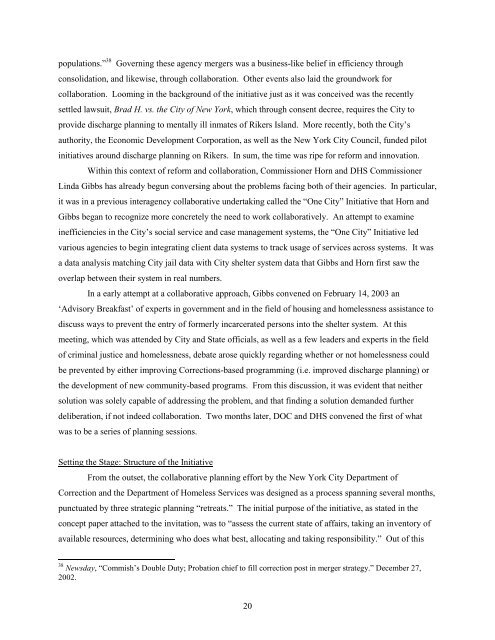Putting the Pieces Back Together: Overcoming Fragmentation to ...
Putting the Pieces Back Together: Overcoming Fragmentation to ...
Putting the Pieces Back Together: Overcoming Fragmentation to ...
You also want an ePaper? Increase the reach of your titles
YUMPU automatically turns print PDFs into web optimized ePapers that Google loves.
populations.‖ 38 Governing <strong>the</strong>se agency mergers was a business-like belief in efficiency through<br />
consolidation, and likewise, through collaboration. O<strong>the</strong>r events also laid <strong>the</strong> groundwork for<br />
collaboration. Looming in <strong>the</strong> background of <strong>the</strong> initiative just as it was conceived was <strong>the</strong> recently<br />
settled lawsuit, Brad H. vs. <strong>the</strong> City of New York, which through consent decree, requires <strong>the</strong> City <strong>to</strong><br />
provide discharge planning <strong>to</strong> mentally ill inmates of Rikers Island. More recently, both <strong>the</strong> City‘s<br />
authority, <strong>the</strong> Economic Development Corporation, as well as <strong>the</strong> New York City Council, funded pilot<br />
initiatives around discharge planning on Rikers. In sum, <strong>the</strong> time was ripe for reform and innovation.<br />
Within this context of reform and collaboration, Commissioner Horn and DHS Commissioner<br />
Linda Gibbs has already begun conversing about <strong>the</strong> problems facing both of <strong>the</strong>ir agencies. In particular,<br />
it was in a previous interagency collaborative undertaking called <strong>the</strong> ―One City‖ Initiative that Horn and<br />
Gibbs began <strong>to</strong> recognize more concretely <strong>the</strong> need <strong>to</strong> work collaboratively. An attempt <strong>to</strong> examine<br />
inefficiencies in <strong>the</strong> City‘s social service and case management systems, <strong>the</strong> ―One City‖ Initiative led<br />
various agencies <strong>to</strong> begin integrating client data systems <strong>to</strong> track usage of services across systems. It was<br />
a data analysis matching City jail data with City shelter system data that Gibbs and Horn first saw <strong>the</strong><br />
overlap between <strong>the</strong>ir system in real numbers.<br />
In a early attempt at a collaborative approach, Gibbs convened on February 14, 2003 an<br />
‗Advisory Breakfast‘ of experts in government and in <strong>the</strong> field of housing and homelessness assistance <strong>to</strong><br />
discuss ways <strong>to</strong> prevent <strong>the</strong> entry of formerly incarcerated persons in<strong>to</strong> <strong>the</strong> shelter system. At this<br />
meeting, which was attended by City and State officials, as well as a few leaders and experts in <strong>the</strong> field<br />
of criminal justice and homelessness, debate arose quickly regarding whe<strong>the</strong>r or not homelessness could<br />
be prevented by ei<strong>the</strong>r improving Corrections-based programming (i.e. improved discharge planning) or<br />
<strong>the</strong> development of new community-based programs. From this discussion, it was evident that nei<strong>the</strong>r<br />
solution was solely capable of addressing <strong>the</strong> problem, and that finding a solution demanded fur<strong>the</strong>r<br />
deliberation, if not indeed collaboration. Two months later, DOC and DHS convened <strong>the</strong> first of what<br />
was <strong>to</strong> be a series of planning sessions.<br />
Setting <strong>the</strong> Stage: Structure of <strong>the</strong> Initiative<br />
From <strong>the</strong> outset, <strong>the</strong> collaborative planning effort by <strong>the</strong> New York City Department of<br />
Correction and <strong>the</strong> Department of Homeless Services was designed as a process spanning several months,<br />
punctuated by three strategic planning ―retreats.‖ The initial purpose of <strong>the</strong> initiative, as stated in <strong>the</strong><br />
concept paper attached <strong>to</strong> <strong>the</strong> invitation, was <strong>to</strong> ―assess <strong>the</strong> current state of affairs, taking an inven<strong>to</strong>ry of<br />
available resources, determining who does what best, allocating and taking responsibility.‖ Out of this<br />
38 Newsday, ―Commish‘s Double Duty; Probation chief <strong>to</strong> fill correction post in merger strategy.‖ December 27,<br />
2002.<br />
20

















